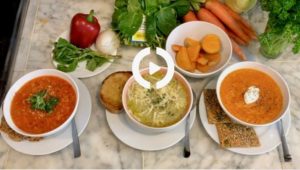Can I eat fruit if I am watching my blood sugars?
Some people with diabetes or pre-diabetes get worried about the sugar content of certain fruits & vegetables. Some have been told to avoid eating certain ‘high Glycemic Index’ fruits & vegetables.
This is a question that comes up a lot so we wanted to write a short post to address it. Thanks to Raj from our Homemade Members group for inspiring this discussion.
The short answer is yes it’s ok to eat whole fruit as part of a balanced diet even if you are watching your blood sugars if you are eating the Homemade way.
Here are the 4 main reasons why whole fruits & vegetables are generally ok – even if you’re watching your blood sugars.
REASON 1: Fruits & vegetables have relatively speaking much less sugar than candy, soda, sports drinks & other processed foods in general
Start reading labels and you may be shocked to see just how much sugar is in common foods including sweetened yogurts, store brought granolas, and breakfast cereals. Not to mention the usual suspects such as candy, cakes, ice cream, and soft drinks.
For example, here is a visual comparison of how much sugar is in pineapple vs. Snapple iced tea!
Source: Sugarstacks.com
REASON 2: Whole fruits & vegetables come packaged with added soluble and insoluble fibers which slow the release of energy into your blood
Slow-release energy equals good energy and this is the way nature packaged most whole fruits & vegetables. In contrast, most processed and refined sugary foods come with almost no fiber.
Here’s a visual comparing the fiber content and blood sugar effects of eating a whole orange, orange juice, orange soda & diet drinks:
REASON 3: Glycemic load together with Glycemic index are the correct measurement to watch if you are worried about your blood sugars
The glycemic index (GI) measures how rapidly a carbohydrate is processed by the body and released as glucose (sugar or energy) into the bloodstream.
GL measures the serving of carbohydrates in a serving of food.
If a food has a high GI, it has carbohydrates readily available for absorption into the bloodstream. This is, in theory, going to spike your blood sugar (aka is bad)
BUT if the same food has a low GL – then it means the overall amount of carbohydrates available per serving in that food is low. What this means, is that even if the sugars are quickly released into your blood, they are not going to have that much effect – because there is not that much of them in total.
The classic example of this is watermelon. It has a high GI (little fiber) BUT it also has a low GL – because it is mainly water. So bottom line, you are not going to raise your blood sugars by eating watermelon fruit.
Here’s a chart showing the GI & GL of some common carbohydrate foods.
REASON 4: You don’t just eat single ingredient foods – so it’s the Glycemic Total that matters
The 4th reason is the most important – and we don’t really see it talked about anywhere. The fact is, you don’t just eat carrot or watermelon or orange or whatever for almost any meal – you generally eat a combination of ingredients, some of which do little to raise your blood sugar such as protein and fat, and some of which help to slow the release of sugars such as fiber.
So when you consider GI and GL if you are watching your blood sugars, we urge you to think in terms of Glycemic Total (GT). That is, overall what is this meal or snack going to do to my blood sugars? Better yet, stop focusing on GI & GL entirely and simply start planning your meals and snacks to include a blend of whole fruits & vegetables, perhaps some added fiber, and then a base fat or protein. In this way, you can be confident you are giving your body the best possible source of energy, nutrition, and controlling your blood sugars. This is what we mean by eating the ‘Homemade way!’
If you have a medical condition, please ask your medical professional before following any advice in this blog post.
Let us know any comments, questions, or feedback. We hope this was helpful!












